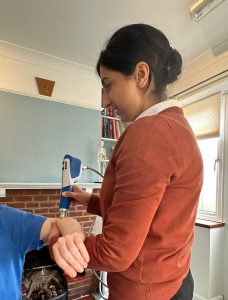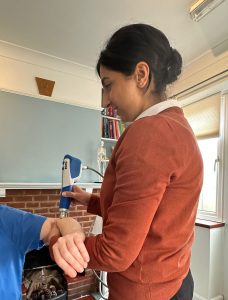
What is extracorporeal radial shockwave therapy?
Extracorporeal Radial Shockwave Therapy is a series of high-energy impulses targeted to the affected area. It may sound a bit daunting, but it is actually very straightforward and nothing to be anxious about.
What is this treatment suitable for?
Shockwave should be thought of as a treatment for chronic pain (i.e. long-standing) that has failed to respond to other interventions. Conditions treated with shockwave therapy will be more than 6 months old, and typically involve tendinopathies.
The National Institute for Clinical Excellence (NICE) have recommended 6 conditions that they consider there is sufficient evidence to support Shockwave Therapy as a recommended treatment option. These are:
- Plantar fasciopathy (pain under the foot or heel)
- Calcific tendinopathy of the shoulder
- Subacromial pain syndrome – usually rotator cuff issues
- Patellar pain syndromes
- Lateral trochanteric pain (pain on the outside of the hip)
- Achilles tendinopathy
- Tennis elbow.
At Haslemere Chiropractic Clinic we use the Swiss Dolorclast Radial Shockwave Equipment, which is the same (and only) equipment used in the research studies referenced by NICE. You can find more information about Shockwave Therapy and the conditions that it is useful for, in a series of videos posted by a specialist osteopath who works extensively with this equipment.
The evidence suggests that if the treatment is effective, and underlying issues have also been dealt with, that Shockwave Therapy can sometimes provide a permanent solution to these problems.
How does it work?
1) Treatment produces an inflammatory response. The body responds by increasing metabolic activity around the site of pain. This stimulates and accelerates the healing process.
2) Shockwave breaks down scar tissue and possibly calcification as well.
3) Transmission of pain is blocked by elimination of P substance.
What are the benefits of Shockwave?
Shockwave Therapy stimulates the body’s natural healing process. There is actually an immediate reduction of pain and improved ease of movement. Shockwave therapy may also reduce the chance of further surgery.
Any potential side effects are minimal provided that the treatment is suitable for you (see later for contra-indications to Shockwave Therapy). Please take a look and contact the Clinic before your before your first Shockwave Therapy session if you have any concerns. On your first Shockwave Therapy session, Kanika will discuss the treatment with you to make sure that it is right for you. there will be an opportunity to ask any questions, before asking for your consent to continue with the treatment.
How long does the treatment last?
The treatment starts with some low intensity impulses for 45 seconds which help the body to prepare for the treatment, and act as an analgesic. 2000 impulses are delivered per session, which last approximately 5 minutes.
Although the shockwave therapy only lasts 5 minutes, we allow 15 minutes per session to allow time for you to ask questions before and after. The chiropractor may also want to assess your problem area, discuss your progress and provide rehabilitation advice.
How many treatments will I need?
Protocol states that three treatments are necessary at weekly intervals. At this point your progress will be assessed, and for many patients this is sufficient. However, sometimes additional treatments may be needed, particularly if you have a long-standing condition. Although it is common to feel an immediate difference in your condition, Shockwave Therapy takes up to 4 months for the full benefit to be felt. Sometimes a further course of treatment may be indicated at this stage if your condition has not fully resolved.
Does the treatment hurt?
You are likely to feel some discomfort during the treatment. However, the settings can be adjusted to adapt to patient tolerance, so you don’t need to worry; the shockwave therapy will always be delivered at a level that you feel able to cope with.
What about after the treatment?
Generally, there will be immediate pain relief. However, there may be some discomfort experienced 2-4 hours after the treatment. The shockwave will trigger an inflammatory response, and this is part of the healing process. The pain should subside within 24 hours.
We want your body to trigger the natural healing response. For this reason, do not use anti-inflammatory medications or ice if you are feeling sore after the treatment.
Use Paracetamol if needed, provided that you able to take this medication.
Other possible side effects include skin reddening, swelling, bruising, and petechiae (tiny pin point spots due to bleeding under the skin).
Although extremely rare, there are a few more serious potential side effects of Shockwave Therapy. These are damage to blood vessels/nerves, and tendon rupture.
Even if it feels good, we advise you to take it easy, and rest the problem area after treatment. You need to allow time for the healing that has been stimulated to occur.
What if it doesn’t work for me?
Although the immediate to short-term effects are usually excellent, the long-term effects of shockwave therapy can take up to 4 months. Sometimes you may need to wait a few months to experience the maximum benefit. If you still have problems after your initial course of shockwave therapy, we recommend that you consult your chiropractor. It is possible that additional shockwave treatments, or an alternative approach, may be necessary.
Contra-indications to Shockwave Therapy
Although Shockwave Therapy is safe for most people, there are some important considerations that may make it unsuitable for you. It is therefore important to take a look at this list, and discuss any concerns with the chiropractor before starting treatment.
Treatment will not be appropriate for you if any of the following relate to you:
- Under 18 years old. Shockwave cannot be applied over bone growth centres in the immature skeleton.
- Cancer in or around the treatment area.
- Infection or skin abrasion in the treatment area.
- Joint replacements underlying the area that is to be treated.
- Corticosteroid injection to the treatment area within the last 6 weeks.
- Ischemic issues (reduced blood supply) at treatment site.
- Shockwave treatment cannot be applied over the surface area of the lungs, heart, bowel, or over major blood vessels and nerves.
- Significant heart or circulatory problems (including pacemakers, high blood pressure, and thrombosis).
- Anti-coagulant (blood thinning) medication and bleeding disorders.
There are also some other considerations. These may not automatically prevent you from receiving Shockwave Therapy, but need to be discussed with the chiropractor before starting treatment to assess the relative risks. These include:
- Injuries that are less than 6 months old. Shockwave therapy is only for chronic conditions, and would not be used on recent injuries.
- Disease or disorders of peripheral blood vessels/nerves.
- History of autoimmune disease, e.g. Rheumatoid Arthritis.
- Recent non-steroidal anti-inflammatory medication.
- Pre-ruptured tendons – we can organize an ultrasound scan for you if there is any concern about this.
Please book a Free Advice Session with Kanika if you would like to find out more, or to discuss whether Shockwave Therapy is suitable for you before booking.
We recommend that you book a series of 3 Shockwave appointments at 1-week intervals to get you started, and to ensure that you get the maximum benefit from the treatment.
You can download all of this information as a PDF:


